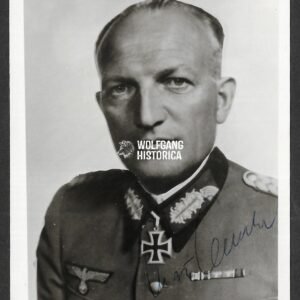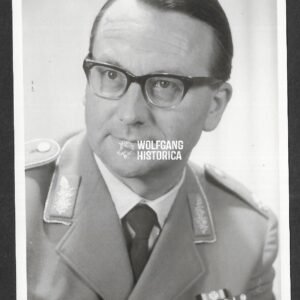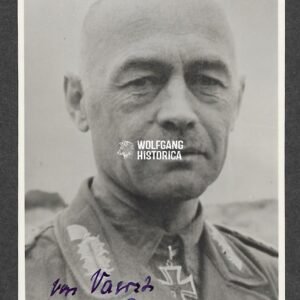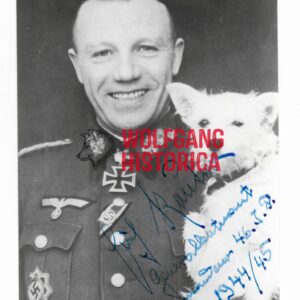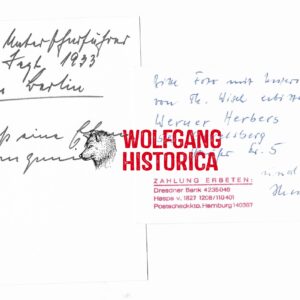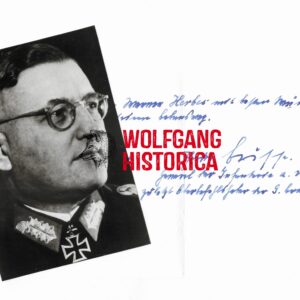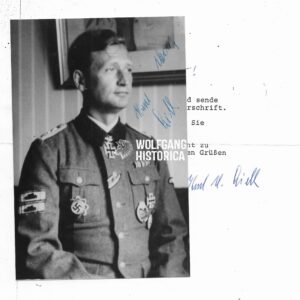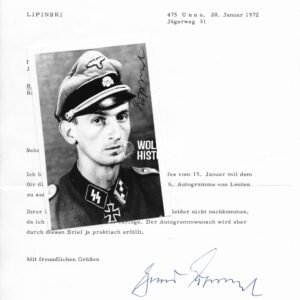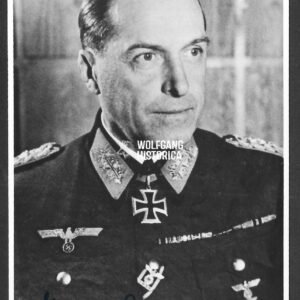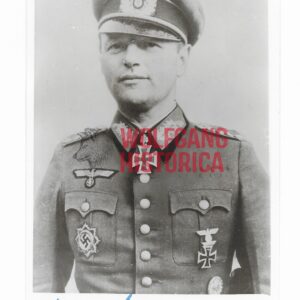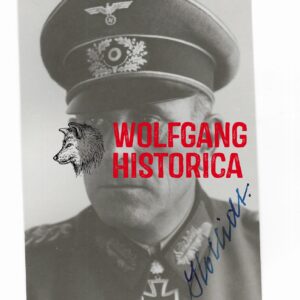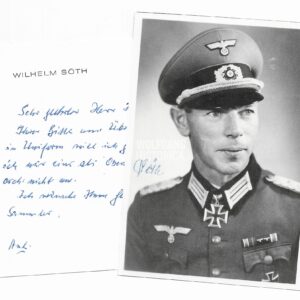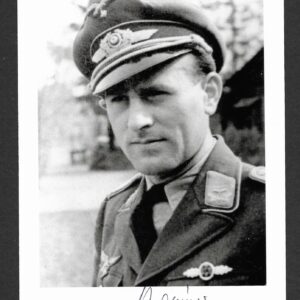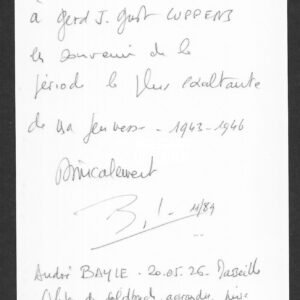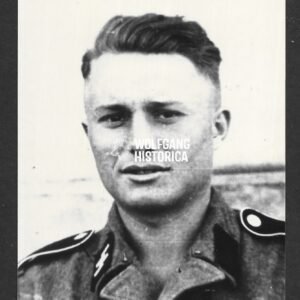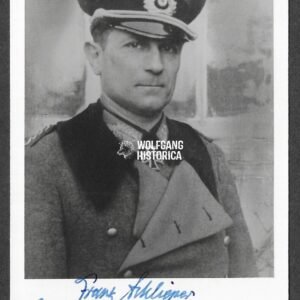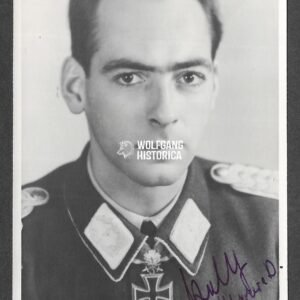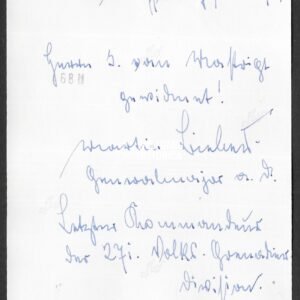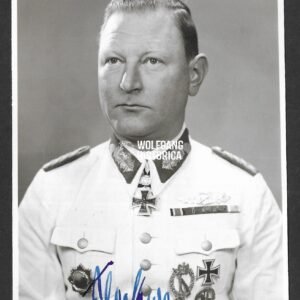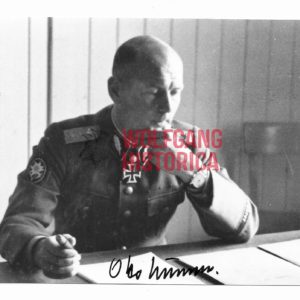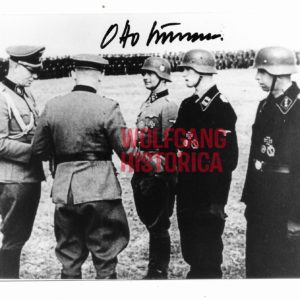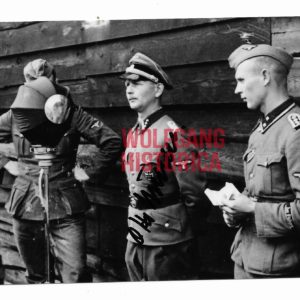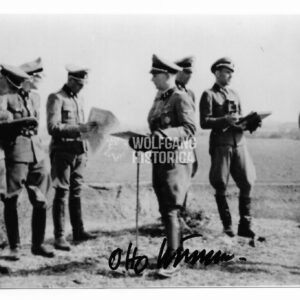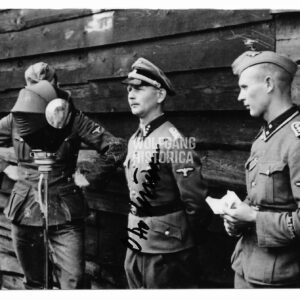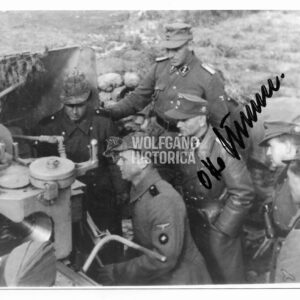Max Lemke – Aufklärungs-Abteilung 17 (last Kdr. of Fallschirm-Panzer-Division “Hermann Göring”)
€55,00Original Postwar Signature on a Postwar Photo of Max Lemke. Generalmajor Max Lemke (7 April 1895, Schwedt † 29 May 1985, Hannover) was a German officer who rose to the rank of Generalmajor during the Second World War. He was decorated with both the German Cross in Gold and the Knight’s Cross of the Iron Cross for his leadership of reconnaissance and armored formations, and he later became the final commander of the elite Fallschirm-Panzer-Division 1 “Hermann Göring.”
Awards and Decorations:
-
Knight’s Cross of the Iron Cross (Ritterkreuz des Eisernen Kreuzes) – 18 October 1941, as Oberst and Kommandeur of Aufklärungs-Abteilung 17, 17. Infanterie-Division.
-
German Cross in Gold (Deutsches Kreuz in Gold) – 23 June 1942.
Career Highlights:
-
A veteran officer of the First World War who continued service in the Reichswehr and Wehrmacht.
-
As commander of Aufklärungs-Abteilung 17 in the 17. Infanterie-Division, he was awarded the Knight’s Cross in October 1941 for his successful leadership in the early phases of the war in the East.
-
Earned the German Cross in Gold in 1942 for further distinction in combat.
-
Rose to command positions within elite formations, becoming the last commander of the Fallschirm-Panzer-Division 1 “Hermann Göring” in the final days of the war.
-
Taken prisoner on 12 May 1945, released a little over a month later on 18 June 1945.
-
After the war, remained active in the Ordensgemeinschaft der Ritterkreuzträger (Association of Knight’s Cross Recipients).
Item Details:
-
Authentic postwar signature of Generalmajor Max Lemke.
-
Signed on a postwar photograph.
-
Condition: Clear and well-preserved autograph.
Collector’s Note:
Lemke’s combination of the German Cross in Gold, Knight’s Cross, and final command of the “Hermann Göring” Division make his autograph a highly desirable piece for collectors of Wehrmacht leadership and elite unit commanders.
Heinz-Günther Guderian – 116. Panzer-Division
€55,00Original Postwar Signature on a Postwar Photo of Heinz-Günther Guderian. Generalmajor Heinz-Günther Guderian (23 August 1914, Goslar † 25 September 2004, Bad Godesberg) was a German officer of the Wehrmacht who rose to the rank of Generalmajor. The son of famed Panzer leader Generaloberst Heinz Guderian (Ritterkreuz mit Eichenlaub), he forged his own distinguished career as a General Staff officer and later in the Bundeswehr. He was awarded the Knight’s Cross of the Iron Cross in 1944 for his leadership in organizing the breakout of the 116. Panzer-Division from the Falaise pocket.
Awards and Decorations:
-
Knight’s Cross of the Iron Cross (Ritterkreuz des Eisernen Kreuzes) – 5 October 1944, as Major im Generalstab, Ia of 116. Panzer-Division.
Awarded for his key role in the Falaise pocket breakout (August 1944). With the situation collapsing and no orders to withdraw, Guderian was instrumental in organizing and directing the division’s successful breakout on the night of 20 August 1944, preventing its total destruction.
Career Highlights:
-
Entered service in 1935, steadily advancing through the officer ranks.
-
Served in staff and Panzer-related assignments throughout the war, reaching the General Staff as Major i.G.
-
Distinguished himself in the West in 1944 during the retreat from Normandy, where his actions earned him the Knight’s Cross.
-
Promoted to Oberstleutnant i.G. in November 1944.
-
Postwar, he joined the Bundeswehr, where he continued a long military career: promoted to Oberst (1960), Brigadegeneral (1963), and ultimately Generalmajor (1968), serving as General der Kampftruppen.
-
Survived the war and lived until 2004, reaching the age of 90.
Item Details:
-
Authentic postwar signature of Generalmajor Heinz-Günther Guderian.
-
Signed on a postwar photograph.
-
Condition: Clear and well-preserved autograph.
Collector’s Note:
As the son of the legendary Heinz Guderian, and himself a Knight’s Cross recipient with a distinguished postwar Bundeswehr career, Heinz-Günther Guderian’s signature is of high collector interest. His role in the Falaise pocket breakout highlights his independent achievements, apart from his father’s fame, and makes this a highly desirable piece for Panzer and Normandy campaign collectors.
Gustav Friedrich Julius von Vaerst – 2. Schützen-Brigade
€55,00Original Postwar Signature on a Postwar Photo of Gustav Friedrich Julius von Vaerst. General der Panzertruppe Gustav von Vaerst (19 April 1894, Meiningen † 10 October 1975, Wiesbaden) was a German officer who rose to the rank of General der Panzertruppe in World War II. He served with distinction as both a frontline commander and later as commander of 5. Panzerarmee in North Africa, where he succeeded Generaloberst Hans-Jürgen von Arnim in May 1943. Shortly after, he was taken prisoner when Axis forces in Tunisia capitulated.
Awards and Decorations:
-
Ritterkreuz des Eisernen Kreuzes – 30 July 1940 as Oberst und Kommandeur of the 2. Schützen-Brigade.
-
Citation (30.08.1940):
“Oberst von Vaerst distinguished himself in an outstanding way throughout the whole campaign in the West. In this capacity he distinguished himself through ruthless dedication during the crossing of the Maas river as well as in subsequent fighting. His calm and masterful command abilities (usually wielded whilst under enemy fire) inspired his subordinates to give their best in all this time. Oberst von Vaerst also showed noteworthy bravery during the capture of the Boulogne fortress.”
-
-
Iron Cross (1914) 1st and 2nd Class.
-
Clasp to the Iron Cross (1939) 1st and 2nd Class.
-
Other Wehrmacht campaign and service awards.
Career Highlights:
-
Entered the Imperial German Army in 1913, serving throughout WWI.
-
Continued his career in the Reichswehr and later the Wehrmacht, specializing in mechanized forces.
-
Promoted to General der Panzertruppe, commanded 2. Schützen-Brigade during the 1940 Western Campaign, later leading higher Panzer formations.
-
In May 1943, appointed commander of 5. Panzerarmee in Tunisia; became a POW when Axis forces surrendered to the Allies shortly after.
-
Remained in captivity until 1947.
Postwar Life:
After his release, von Vaerst lived in Wiesbaden until his death in 1975.
Item Details:
-
Authentic postwar signature of General der Panzertruppe Gustav von Vaerst.
-
Signed on a postwar photograph. ID-size.
-
Condition: Very good, clear autograph.
Collector’s Note:
As the last commander of 5. Panzerarmee in North Africa, von Vaerst’s career is closely tied to the final phase of the Axis struggle in Tunisia. His Ritterkreuz citation for leadership in France 1940 adds further depth to his profile, making his signature a highly desirable addition for collectors of Panzer leaders and Afrika Korps history.
Georg Robert Besslein – SS-Festungs-Grenadier-Regiment “Besslein”
€60,00Sylvester Stadler – “Der Führer” & “Hohenstaufen” (Swords + NKIG)
€60,00Hugo Primozic – Sturmgeschütz-Abteilung 667 (Eichenlaub)
€60,00Original Postwar Signature on a Wartime Postcard of Hugo Primozic. Oberleutnant Hugo Primozic (16.02.1914 † 18.03.1996) earned the Ritterkreuz on September 19, 1942 as Wachtmeister und Zugführer of the 2. Batterie/ Sturmgeschütz-Abteilung 667 and the Eichenlaub on January 25, 1943 as Oberwachtmeister und Zugführer of the 2. Batterie/ Sturmgeschütz-Abteilung 667. Good condition.
Ritterkreuz: “Awarded for destroying 45 enemy tanks during the fighting in the central sector of the Eastern front. Of these, Primozic destroyed 24 in just one day (15.09.1942) and in doing so was able to prevent an enemy breakthrough.” Eichenlaub: “Awarded for bringing his total of tanks destroyed to 60. During a counterattack on 11.12.1942 he destroyed 7 tanks in one day.”Provenance: This signature comes from one of the largest postwar signature collection I’ve ever commissioned. This collection was started by a Waffen-SS Veteran, Werner H., in the 1950’s until he passed away.
Wilhelm Bleckwenn – Grenadier-Regiment 487 (267.Inf.Div.) (Eichenlaub)
€60,00Original Postwar Signature on a Postwar Photo of Wilhelm Bleckwenn. Generalmajor Wilhelm Bleckwenn (21.10.1906 † 10.05.1989) earned the Ritterkreuz on April 6, 1944 as Oberst und Kommandeur of the Grenadier-Regiment 487 and the Eichenlaub on October 18, 1944 as Oberst und Kommandeur of the Grenadier-Regiment 487 of the 267. Infanterie-Division. Good condition.
Following Heeresgruppe Mitte’s collapse during Operation Bagration, Oberst Bleckwenn and a small Kampfgruppe under his command managed to break through to East Prussia after a period of 44 days of fighting through Belorussian forests. In the process he and his men overcame the torrential currents of the Memel river on the night of the 04./05.08.1944 while crossing it at a point south of Druschkiniki. He was subsequently awarded the Oakleaves for this noteworthy accomplishment.
Provenance: This signature comes from one of the largest postwar signature collection I’ve ever commissioned. This collection was started by a Waffen-SS Veteran, Werner H., in the 1950’s until he passed away.
Erich Reuter – Infanterie-Regiment 122 & 46. Infanterie-Division (Eichenlaub)
€60,00Original Postwar Signature on a Postwar Photo of Erich Reuter. Generalleutnant Erich Reuter (30.03.1904 † 30.10.1989) earned the Ritterkreuz on August 17, 1942 as Oberstleutnant und Kommandeur of the Infanterie-Regiment 122 of the 50. Infanterie-Division and the Eichenlaub on January 21, 1945 as Generalmajor und Kommandeur of the 46. Infanterie-Division. Good condition.
Provenance: This signature comes from one of the largest postwar signature collection I’ve ever commissioned. This collection was started by a Waffen-SS Veteran, Werner H., in the 1950’s until he passed away.
Alexander Conrady – Grenadier-Regiment 118 (Eichenlaub)
€60,00Original Postwar Signature on a Postwar Photo of Alexander Conrady. Generalmajor Alexander Conrady (16.07.1903 in Neu-Ulm † 21.12.1983 in Augsburg) earned the Ritterkreuz des Eisernen Kreuzes on October 17, 1942 as Oberstleutnant und Kommandeur of the I. Bataillon/ Infanterie-Regiment 118 and the Eichenlaub on August 22, 1943 as Oberst und Kommandeur of the Grenadier-Regiment 118 of the 36. Infanterie-Division.
Provenance: This signature comes from one of the largest postwar signature collection I’ve ever commissioned. This collection was started by a Waffen-SS Veteran, Werner H., in the 1950’s until he passed away.
Albert Stenwedel – 13. Waffen-Gebirgs-Division der SS “Handschar”
€60,00Sylvester Stadler – “Der Führer” & “Hohenstaufen” (Swords + NKIG)
€60,00Theodor Busse – Heeresgruppe Süd
€60,00Original Postwar Signature on a Photo & Letter of Theodor Busse. Generalleutnant Theodor Busse (15.12.1887 † 21.10.1986) earned the Ritterkreuz des Eisernen Kreuzes on January 30, 1944 as Generalleutnant und Chef des Generalstabes of the Heeresgruppe Süd.
Provenance: This signature comes from one of the largest postwar signature collection I’ve ever commissioned. This collection was started by a Waffen-SS Veteran, Werner H., in the 1950’s until he passed away.
Sylvester Stadler – “Der Führer” & “Hohenstaufen” (Swords + NKIG)
€60,00Hellmuth Heye – Kommandant of schwere Kreuzer “Admiral Hipper”
€60,00Sylvester Stadler – “Der Führer” & “Hohenstaufen” (Schwertern + NKIG)
€60,00Sylvester Stadler – “Der Führer” & “Hohenstaufen” (Schwertern + NKIG)
€60,00Günther Rall – Jagdgeschwader 52 (Schwertern, 275 Victories!) (Large Size!)
€60,00Günther Rall – Jagdgeschwader 52 (Schwertern, 275 Victories!) (Large Size!)
€60,00A4 Signed Photograph – Martin Semmelrogge (“Das Boot”)
€60,00An original A4-sized promotional photograph personally signed by Martin Semmelrogge, who famously portrayed 2nd Watch Officer in Wolfgang Petersen’s acclaimed 1981 submarine epic Das Boot.
Semmelrogge’s performance contributed to the film’s gripping portrayal of life aboard a German U-Boat during World War II. Das Boot remains one of the most highly regarded war films ever made, praised for its authenticity, atmosphere, and intense character-driven storytelling.
This signed photo is ideal for fans of classic cinema, war film collectors, or anyone seeking a piece of memorabilia from one of the most iconic submarine films in movie history.
A4 Signed Photograph – Herbert Grönemeyer (“Das Boot”)
€60,00A high-quality A4-sized promotional photograph personally signed by Herbert Grönemeyer, who played Leutnant Werner in Wolfgang Petersen’s acclaimed 1981 film Das Boot.
As the young war correspondent aboard U-96, Grönemeyer delivered a heartfelt and nuanced performance, guiding the audience through the claustrophobic tension and human drama of life aboard a WWII German U-Boat.
Today, Das Boot is celebrated as one of the greatest war films of all time, praised for its realism, emotional depth, and unforgettable ensemble cast. This signed piece offers a striking tribute to Grönemeyer’s role and is an ideal collectible for Das Boot fans, WWII enthusiasts, and admirers of German cinema.
Johannes Scherg – SS-Panzer-Aufklärungs-Abteilung 4
€60,00Karl-Heinz Lichte – SS-Panzer-Regiment 5 “Wiking”
€60,00Dr. Hans Lipinski – SS-Flak-Abteilung 18 “Horst Wessel”
€60,00Max-Josef Pemsel – 6. Gebirgs-Division
€60,00Original Postwar Signature on a Postwar Photo of Max-Josef Pemsel. Generalleutnant Max-Josef Pemsel (15 January 1897, Regensburg † 30 June 1985, Munich) was a German Army officer who rose to the rank of Generalleutnant during the Second World War. A veteran of both World Wars, he distinguished himself as commander of the 6. Gebirgs-Division in northern Finland, where he was awarded the Knight’s Cross of the Iron Cross and cited in the Wehrmachtbericht. After the war, Pemsel became a senior officer in the Bundeswehr, serving as NATO commander in Schleswig-Holstein.
Awards and Decorations:
-
Knight’s Cross of the Iron Cross (Ritterkreuz des Eisernen Kreuzes) – 9 December 1944, as Generalmajor and Kommandeur of 6. Gebirgs-Division.
Awarded for his leadership during the rearguard battles of early October 1944, when German forces retreated from northern Finland. Pemsel played a decisive role in enabling major elements of the 20. Gebirgsarmee to escape. Under his command, the Petsamo–Kirkenes road was reopened after heavy fighting, preventing a Soviet encirclement of the 6. Gebirgs-Division and frustrating a pincer attack against XIX. Gebirgs-Armeekorps. His actions earned him not only the Knight’s Cross, but also a commendation in the Wehrmachtbericht of 3 November 1944.
Career Highlights:
-
Served as an officer in World War I, later continuing his career in the Reichswehr.
-
Developed as a skilled staff officer during the interwar years.
-
Commanded the 6. Gebirgs-Division, where he distinguished himself in the demanding Arctic and Finnish theaters.
-
Later served as Chief of Staff of the 7. Armee in 1944, overseeing defenses in Normandy during the D-Day invasion.
-
Captured in 1945 and released from captivity in 1948.
-
Entered the Bundeswehr in 1956, rising to Generalleutnant and serving as NATO’s commander in Schleswig-Holstein until his retirement.
-
Lived in Munich until his death in 1985.
Item Details:
-
Authentic postwar signature of Generalleutnant Max-Josef Pemsel.
-
Signed on a postwar photograph.
-
Condition: Clear and well-preserved autograph.
Collector’s Note:
Pemsel’s recognition as commander of the 6. Gebirgs-Division in Finland — including both the Knight’s Cross and a Wehrmachtbericht mention — marks him as one of the notable late-war Gebirgsjäger leaders. His long postwar service as a Bundeswehr and NATO general adds further interest, making his autograph especially appealing to collectors of both WWII mountain troops and Cold War German leadership.
Horst von Mellenthin – 205. Infanterie-Division (Eichenlaub)
€65,00Karl Hollidt – Oberbefehlshaber der 6. Armee (Eichenlaub)
€65,00Provenance: This signature comes from one of the largest postwar signature collection I’ve ever commissioned. This collection was started by a Waffen-SS Veteran, Werner H., in the 1950’s until he passed away.
Erich Pietzonka – Fallschirmjäger-Regiment 7 (Eichenlaub)
€65,00Original Postwar Signature on a Postwar Photo of Erich Pietzonka. Oberst Erich Pietzonka (04.10.1906 † 18.12.1989) earned the Ritterkreuz des Eisernen Kreuzes on September 5, 1944 as Oberstleutnant und Kommandeur and the Eichenlaub on September 16, 1944 as Oberst und Kommandeur of Fallschirmjäger-Regiment 7 of the 2. Fallschirmjäger-Division.
Provenance: This signature comes from one of the largest postwar signature collection I’ve ever commissioned. This collection was started by a Waffen-SS Veteran, Werner H., in the 1950’s until he passed away.
Wilhelm Söth – Artillerie-Regiment 56 (1. Panzer-Division)
€65,00Gerhard Lindner – 346. Infanterie-Division (Generalmajor, Arnhem)
€65,00Anton Benning – Jagdgeschwader 301 (Stalingrad & 28 Victories!)
€65,00Hans Siegel – SS-Panzer-Regiment 12 “Hitlerjugend” (Normandy)
€65,00André Bayle – 33. Waffen-Grenadier-Division der SS “Charlemagne” (French Volunteer)
€65,00Franz Schlieper – Grenadier-Regiment 94 & Grenadier-Regiment 1132
€65,00Original Postwar Signature on a Postwar Photo of Franz Schlieper. Generalmajor Franz Schlieper (22 August 1905 † 4 April 1974) was a career officer in the German Army during the Second World War who rose to divisional command. He was decorated with both the German Cross in Gold and the Knight’s Cross of the Iron Cross for his battlefield leadership.
Awards and Decorations:
-
German Cross in Gold (Deutsches Kreuz in Gold) – 10 January 1944, as Oberst and Kommandeur of Grenadier-Regiment 94, 32. Infanterie-Division (Heer).
-
Knight’s Cross of the Iron Cross (Ritterkreuz des Eisernen Kreuzes) – 21 September 1944, as Oberst and Kommandeur of Grenadier-Brigade 1132, Führer of the 73. Infanterie-Division (Heer).
Career Highlights:
-
Entered the Reichswehr as a young officer and advanced steadily through the interwar years.
-
Distinguished himself as regimental commander with the 32. Infanterie-Division, earning the German Cross in Gold during the heavy fighting on the Eastern Front.
-
Promoted to brigade and divisional command, he received the Knight’s Cross in late 1944 for his leadership of Grenadier-Brigade 1132 and acting command of the 73. Infanterie-Division.
-
Captured by Soviet forces in May 1945 and held in captivity until 1955.
-
Returned to Germany after release and lived there until his death in 1974.
Item Details:
-
Authentic postwar signature of Franz Schlieper.
-
Signed on a postwar photograph.
-
Condition: Excellent preserved example, with clear autograph.
Karl Bodenschatz – Liaison Officer between Hermann Göring & Adolf Hitler (Wounded on July 20, 1944)
€65,00Original Postwar Signature on the Reverse of an Wartime Postcard of Karl-Heinrich Bodenschatz. General der Flieger Karl-Heinrich Bodenschatz (10 December 1890, Rehau † 25 August 1979, Erlangen) was a German general and veteran of both World Wars. In the First World War he served as adjutant to the famous “Red Baron,” Manfred von Richthofen. During the Second World War, Bodenschatz became the liaison officer between Hermann Göring and Adolf Hitler, serving at the highest levels of the Third Reich’s military command.
On 20 July 1944, while serving at Hitler’s headquarters, Bodenschatz was gravely wounded in the assassination attempt at the Wolf’s Lair in Rastenburg. He received the 20. Juli 1944 Wound Badge in Gold, one of the rarest decorations of the war, awarded only to those injured in the failed plot. Bodenschatz was fortunate to survive, as officers immediately to his left and right were killed by the blast.
Item Details:
-
Authentic postwar signature of General der Flieger Karl-Heinrich Bodenschatz.
-
Signature is located on the reverse of an original wartime postcard.
-
Condition: Clear autograph on reverse; postcard well-preserved.
Collector’s Note:
As adjutant to the legendary Red Baron in WWI and later liaison between Göring and Hitler in WWII, Bodenschatz represents a unique bridge between Germany’s two great conflicts. His survival of the 20 July plot and the award of the extremely rare Gold Wound Badge (20. Juli 1944) make his signed material highly sought after. This example, signed on the reverse of an original wartime postcard, adds further desirability for serious collectors of Luftwaffe and high-command memorabilia.
Dietrich Peltz – Sturzkampfgeschwader 77 (Schwertern)
€65,00Original Postwar Signature on a Postwar Photo of Dietrich Peltz. Generalmajor Dietrich Peltz (6 September 1914, Gießen † 10 August 2001, Munich) was one of the Luftwaffe’s most decorated bomber officers, rising to the rank of Generalmajor and earning the Knight’s Cross of the Iron Cross with Oak Leaves and Swords. Recognized for his aggressive leadership in dive-bomber operations and later as a planner of strategic bombing raids, he became one of the youngest generals in the German armed forces.
Awards and Decorations:
-
Knight’s Cross of the Iron Cross (Ritterkreuz des Eisernen Kreuzes) – 14 October 1940, as Oberleutnant with the Stab of Sturzkampfgeschwader 77.
-
Oak Leaves to the Knight’s Cross (Eichenlaub zum Ritterkreuz des Eisernen Kreuzes, 53rd award) – 31 December 1941, as Hauptmann and Kommandeur of II./ Sturzkampfgeschwader 77.
-
Swords to the Knight’s Cross with Oak Leaves (Schwerter zum Ritterkreuz des Eisernen Kreuzes, 33rd award) – July 1943, as Oberst im Generalstab and Angriffsführer England.
Career Highlights:
-
Distinguished himself as a Stuka pilot and commander in the early campaigns, earning the Knight’s Cross in 1940.
-
As Kommandeur of II./StG 77, led his group in intensive dive-bombing operations on the Eastern Front, where his effectiveness was recognized with the Oak Leaves in 1941.
-
Later transferred to the Luftwaffe General Staff, becoming Angriffsführer England, tasked with planning and executing bomber raids against Britain in 1943, which earned him the Swords.
-
Promoted rapidly due to his ability, he was one of the youngest officers to reach the rank of Generalmajor.
-
Survived the war, later living in Munich until his death in 2001.
Item Details:
-
Authentic postwar signature of Generalmajor Dietrich Peltz.
-
Signed on a postwar photograph.
-
Condition: Clear and well-preserved autograph.
Collector’s Note:
Peltz’s combination of frontline combat command with Stuka units and his later role as a strategic bombing planner make him an especially interesting figure. His awards — the Knight’s Cross with Oak Leaves and Swords — place him among the most highly decorated Luftwaffe officers, making his signed photo a desirable addition for collectors of decorated bomber leaders and high-ranking Luftwaffe personalities.
Martin Bieber – Grenadier-Regiment 184 & Divisionsgruppe 86 (Eichenlaub)
€65,00Original Postwar Signature on a Postwar Photo of Martin Bieber. Generalleutnant Martin Bieber (17 November 1900, Tabarz † 19 October 1974, Bad Reichenhall) was a German Army officer who rose to the rank of Generalleutnant during the Second World War. He distinguished himself as a regimental and divisional commander on the Eastern Front and was decorated with the Knight’s Cross of the Iron Cross with Oak Leaves for his leadership.
Awards and Decorations:
-
Knight’s Cross of the Iron Cross (Ritterkreuz des Eisernen Kreuzes, 1901st award) – 28 July 1943, as Oberst and Kommandeur of Grenadier-Regiment 184, 86. Infanterie-Division, XXXXI. Panzer-Korps, 9. Armee, Heeresgruppe Mitte.
-
Oak Leaves to the Knight’s Cross (Ritterkreuz mit Eichenlaub, 601st award) – 2 September 1944, as Oberst and Führer of Divisionsgruppe 86, Korps-Abteilung E, XX. Armeekorps, 2. Armee, Heeresgruppe Mitte.
Career Highlights:
-
Career officer from the Reichswehr era who served with distinction throughout WWII.
-
As commander of Grenadier-Regiment 184, he earned the Knight’s Cross in 1943 during the heavy fighting on the central sector of the Eastern Front.
-
Promoted to divisional leadership, taking over Divisionsgruppe 86, later absorbed into Korps-Abteilung E, where he proved his resilience during the defensive battles of 1944.
-
Awarded the Oak Leaves in September 1944 for his skillful leadership of these ad-hoc formations under extreme pressure during the Soviet summer offensives.
-
Promoted to Generalleutnant before the end of the war, surviving captivity and later settling in Bavaria.
- Commander of 271. Volksgrenadier-Division.
Item Details:
-
Authentic postwar signature of Generalleutnant Martin Bieber.
-
Signed on a postwar photograph.
-
Condition: Clear and well-preserved autograph.
Hermann Niehoff – 371. Infanterie-Division (Eichenlaub)
€65,00Original Postwar Signature on a Postwar Photo of Hermann Niehoff. General der Infanterie Hermann Niehoff (3 April 1897, Papenburg † 5 November 1980, Riegsee) was a career officer of the German Army who rose to the rank of General der Infanterie during the Second World War. He distinguished himself as a regimental and divisional commander on the Eastern Front, earning the Knight’s Cross with Oak Leaves. In the final days of the war, he became the last commander of the German fortress of Breslau.
Awards and Decorations:
-
Ehrenblattspange des Heeres und Waffen-SS – 29 September 1941, as Oberstleutnant and Kommandeur of Infanterie-Regiment 464, 253. Infanterie-Division. (366th award)
-
German Cross in Gold (Deutsches Kreuz in Gold) – 6 January 1942, as Oberstleutnant and Kommandeur of Infanterie-Regiment 464, 253. Infanterie-Division. (Award 46/11)
-
Knight’s Cross of the Iron Cross (Ritterkreuz des Eisernen Kreuzes, 3143rd award) – 15 June 1944, as Generalleutnant and Kommandeur of the 371. Infanterie-Division.
Awarded for his Division’s successful withdrawal actions and subsequent defense along the Bug river in March 1944, where Niehoff’s personal energy and determination were crucial to preventing a Soviet breakthrough.
-
Wehrmachtbericht Mention – 11 August 1944, as Generalleutnant and Kommandeur of 371. Infanterie-Division, noted for the Division’s performance on the Eastern Front.
-
Oak Leaves to the Knight’s Cross (Ritterkreuz mit Eichenlaub, 808th award) – 5 March 1945, as Generalleutnant and Kommandeur of the 371. Infanterie-Division, 17. Armee, Heeresgruppe Mitte.
In February 1945, Niehoff’s division repelled a major Soviet offensive near Ratibor, fighting tenaciously to hold open Reichsstraße 118 despite repeated assaults, some of which were fought off in close combat. His determined leadership earned him the Oak Leaves.
Career Highlights:
-
World War I veteran who rejoined the Reichswehr and steadily advanced during the interwar years.
-
On the Eastern Front, led Infanterie-Regiment 464 and later the 371. Infanterie-Division in some of the hardest fighting of the war.
-
Decorated with the Knight’s Cross and Oak Leaves for outstanding leadership during defensive battles in 1944–45.
-
In April 1945, appointed Kommandant of Breslau, one of the Reich’s last fortress cities, where he commanded until surrendering the city to the Red Army on 6 May 1945.
-
Survived Soviet captivity and was released in 1955. He lived in Bavaria until his death in 1980.
Item Details:
-
Authentic postwar signature of General der Infanterie Hermann Niehoff.
-
Signed on a postwar photograph.
-
Condition: Clear and well-preserved autograph.
Collector’s Note:
Niehoff’s significance lies both in his Knight’s Cross with Oak Leaves for frontline command and his role as the last Fortress Commander of Breslau, one of the most famous German Festungen of WWII. His autograph is highly sought after by collectors of high-ranking Heer generals, Eastern Front commanders, and those focusing on the final battles of 1945.
Wilhelm Bleckwenn – Grenadier-Regiment 487 (Eichenlaub)
€65,00Original Postwar Signature on a Postwar Photo of Wilhelm Bleckwenn. Generalmajor Wilhelm Bleckwenn (21 October 1906 † 10 May 1989) was a German Army officer who rose to the rank of Generalmajor during the Second World War. A front-line regimental commander, he earned both the Knight’s Cross of the Iron Cross and later the Oak Leaves for his leadership of Grenadier-Regiment 487 of the 267. Infanterie-Division.
Awards and Decorations:
-
Knight’s Cross of the Iron Cross (Ritterkreuz des Eisernen Kreuzes) – 6 April 1944, as Oberst and Kommandeur of Grenadier-Regiment 487, 267. Infanterie-Division.
-
Oak Leaves to the Knight’s Cross (Ritterkreuz mit Eichenlaub, 638th award) – 18 October 1944, as Oberst and Kommandeur of Grenadier-Regiment 487, 267. Infanterie-Division.
Oak Leaves Citation:
Following the collapse of Heeresgruppe Mitte during Operation Bagration, Oberst Bleckwenn and a small Kampfgruppe under his command managed to break through to East Prussia after 44 days of continuous fighting through the Belorussian forests. In one of the most notable actions of this retreat, on the night of 4/5 August 1944, Bleckwenn led his men across the Memel river south of Druschkiniki, overcoming torrential currents and enemy resistance. For this remarkable achievement of leadership and perseverance, he was awarded the Oak Leaves.
Career Highlights:
-
Career officer who served in both the Reichswehr and Wehrmacht.
-
Commanded Grenadier-Regiment 487 with distinction on the Eastern Front.
-
Decorated with the Knight’s Cross in April 1944 for earlier combat leadership.
-
Survived the war, later attaining the rank of Generalmajor.
-
Lived until 1989, passing away at the age of 82.
Item Details:
-
Authentic postwar signature of Generalmajor Wilhelm Bleckwenn.
-
Signed on a postwar photograph.
-
Condition: Good, with a clear and well-preserved autograph.
Collector’s Note:
Bleckwenn’s Oak Leaves citation highlights one of the most dramatic survival and retreat stories of 1944. His leadership during the collapse of Heeresgruppe Mitte and his regiment’s epic retreat into East Prussia makes his signature a highly desirable piece for Eastern Front collectors.
Otto Kumm – Regiment “Der Führer” & Division “Prinz Eugen” (Swords)
€70,00Otto Kumm – Regiment “Der Führer” & Division “Prinz Eugen” (Swords)
€70,00Otto Kumm – Regiment “Der Führer” & Division “Prinz Eugen” (Swords)
€70,00Otto Kumm – Regiment “Der Führer” & Division “Prinz Eugen”
€70,00Original Postwar Signature on a Postwar Photo of Otto Kumm. SS-Brigadeführer Otto Kumm (01.10.1909 † 23.03.2004) earned the Ritterkreuz on February 16, 1942 as SS-Obersturmbannführer und Kommandeur of the SS-Infanterie-Regiment “Der Führer”, the Eichenlaub on April 6, 1943 as SS-Obersturmbannführer und Kommandeur of the SS-Panzer-Grenadier-Regiment 4 “Der Führer” of the 2. SS-Panzer-Division “Das Reich“ and the Schwertern on March 17, 1945 as SS-Brigadeführer und Kommandeur of 7. SS-Freiwilligen-Gebirgs-Division “Prinz Eugen”.
Read more on Otto Kumm (Wikipedia)

